Pulsar |
Pulsar is a neutron star | |  Automatic translation Automatic translation | | Updated June 01, 2013 |
Neutron stars are very small but very dense (1 billion tons per cubic centimeter). They concentrate the mass of a star like the Sun in a radius of about 10 km, corresponding to the so-called Chandrasekhar mass.
These are the remnants of very massive stars more than ten solar masses. When a massive star reaches the end of existence, it collapses on itself, producing an impressive explosion called a supernova.
The explosion scattered huge quantities of matter in space but spares the heart of the star. The heart contracts and becomes largely a neutron star. These objects, called magnetars, have very strong magnetic fields. Along the magnetic axis spreads charged particles, electrons, for example, which produce synchrotron radiation. If it rotates rapidly on its own, so it projects along its magnetic axis a thin brush radiation, we then call "pulsar". | | NB: Chandrasekhar Limit is the mass above which a star cold end of life collapses into a black hole. The most massive white dwarfs have a mass equal to 1.4 times the Sun. Any lower mass star will evolve into white dwarfs quietly once exhausted its nuclear fuel. If its mass is greater than it suffered a catastrophic collapse in a few seconds it turns into a pulsar or black hole. Image: IC 443 follows a stellar explosion, the ultimate fate of massive stars. In this false color composite image can be seen the remnants of supernova still vibrating across the spectrum (blue), optical (red) and x-rays (green). IC 443 is also known as the Jellyfish nebula, the image covers about 65 light years. IC443 is located at the estimated distance of 5000 light years. Credit image: Chandra xray | | 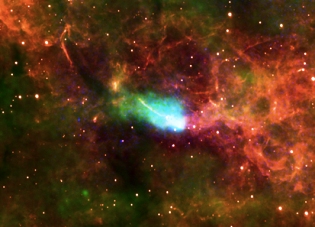 |
Discovery of first pulsar | | | | |
Pulsars are dead stars, extremely dense dwarfs turning on itself, much faster than the other stars (from 10 to 1000 times per second).
Their light sweeps through space like a lighthouse. In 1967 with the radio telescope sensitive to flicker, as Jocelyne Bell, a student from Hewish, reveals an anomaly in the swarming of radio waves: the scruff. Jocelyne Bell sought the scruff for months and discovered a series of regular pulsations.
These impulses seemed too regular to be natural. John Pilkington was able to measure the distance from Earth to pulsar, 1000 al. This clock 1.33 seconds was too perfect to be from a natural process.
At first the scientists wondered if it was not there, the signs of intelligence. Hewish through the Doppler effect, put an end to this hope of signals from another civilization.
Subsequently several pulsars have been discovered. The radio sources from neutron star and a pulsar is a neutron star spinning rapidly, corresponding to the heart of a collapsed massive star that exploded as a supernova at the end of life.
In general the explosion of a supernova leaving a celestial super compact in his heart called SNR (Super Nova Rest). | | This is the FGST (Fermi Gamma-ray Space Telescope) that NASA has discovered for the first time a pulsar, whose name comes from the abbreviation of pulsating radio source.
This neutron star rapid rotation on the image below is cons-aged 10,000 years, it flashes about three times per second by expelling its gamma rays in space.
Five French teams from IN2P3 / CNRS, CEA / IRFU and the INSU / CNRS contributed to analyzing and interpreting these results, published in the journal Science (Science Express on 16 October 2008).
Astronomers have identified nearly 1800 pulsars in the Milky Way, found through their radio signals or their weak pulses in visible light and X-rays Image: The Fermi telescope has discovered this pulsar with its gamma-ray emission. The pulsar is located in the remnants of supernova CTA1, located about 4600 light years away in the constellation Cepheus.
Credit NASA / S. Pineault, DRAO | | 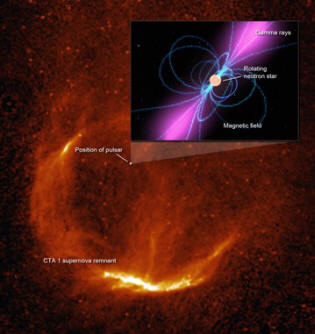 |
Crab Nebula or M1 or NGC 1952 | | | | |
The Crab Nebula or M1 is the typical result of a starburst or visible residue of the explosion of a supernova. This supernova exploded in 1054, observed by several astronomers of the Far East from July 1054 to April 1056. These mysterious filaments, are not only extremely complex, but seem to have less mass than the original supernova and higher speed than expected. It is situated at a distance of about 2 kiloparsecs is 6300 light years from Earth in the constellation Taurus. The nebula has a diameter of 11 light years and its expansion velocity is 1500 km/s. This is the first astronomical object that has been identified with a supernova explosion. In the center of the nebula is a pulsar, that is to say, a neutron star as massive as the Sun but with only the size of a small town.
The Crab Pulsar rotates on itself at a speed of 30 times per second. It radiates about 200,000 times more energy than the Sun and this in an extremely wide frequency range. A supernova is the visible phenomenon, directly from the cataclysmic explosion of a star that leads to its total destruction and therefore the death of the star. This explosion is accompanied by a gigantic increase its brightness as seen from Earth, which can last several weeks and even months. | | It is visible in daylight and at night it can be as bright as the moon and even give a shadow objects.
A supernova is therefore often as a new star, whence its name, nova. Supernovae are rare events in our Milky Way, about one to three per century, by cons across the universe, we observe every day.
It was during the supernova explosion the star releases its chemical elements synthesized during its existence and after the explosion itself.
The shockwave from the supernova favors the formation of new stars accelerating contraction of regions of gas and dust in the interstellar medium.
The novae, unlike supernovae are thermonuclear explosions from causing a partial destruction of the star by expelling a portion of its surface into interstellar space. Image: The Crab Nebula or M1 is the typical result from a star explosion. The death of a star can be mild or severe, depending on its mass.
Picture taken by the Hubble Space Telescope. | | 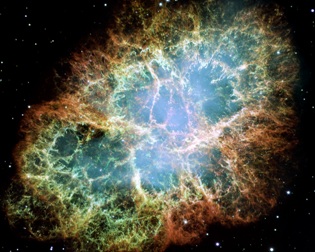 |
Glove of pulsar | | | | |
PSR B1509-58 is a relatively young pulsar because the light from the supernova that gave birth would have reached the Earth 1700 years ago.
It was first detected as a source of X-ray satellite Uhuru, then as a source by pulsing the Einstein satellite in 1982 and observed in the radio domain.
His radio show is relatively low, its discovery in the radio would not have been possible without his prior discovery in the field of X-rays This neutron star of 20 km in diameter rotates on itself seven times per second, this dynamo cosmic powers a wind of charged particles. In this picture the wind energy generates X-rays from the nebula above the image, the Chandra space observatory. The low energy X-rays are colored red, the intermediate energies are green and high energies in blue. | | The pulsar itself is at the heart of the bright central region at the bottom of the complex structure that irresistibly evokes an outstretched hand or a glove. PSR B1509-58 is located about 17,000 light years from us, in the southern constellation Circinus.
At this distance, the Chandra image covers a field of 100 light-years wide. Image: Credit: P. Slane (Harvard-Smithsonian CfA) et al., CXC, NASA | | 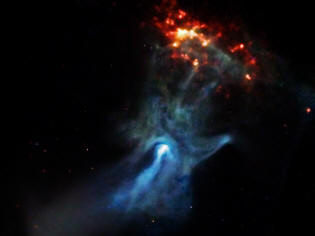 |
 Automatic translation
Automatic translation






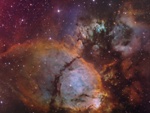 Heart and soul nebula
Heart and soul nebula
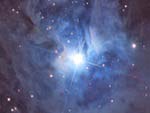 Clouds of dust
Clouds of dust
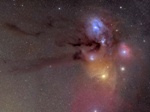 Black River of the Giant Antares
Black River of the Giant Antares
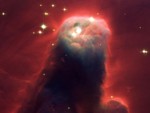 Cone Nebula, nightmare creature
Cone Nebula, nightmare creature
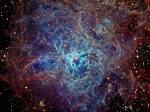 Gigantic Tarantula Nebula
Gigantic Tarantula Nebula
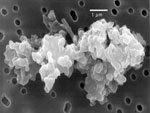 Interstellar dust
Interstellar dust
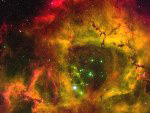 The sculpture of the Rosette
The sculpture of the Rosette
 Journey to the center of our galaxy
Journey to the center of our galaxy
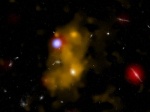 Lyman-α blob
Lyman-α blob
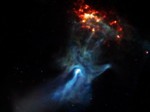 The pulsar which evokes an outstretched hand
The pulsar which evokes an outstretched hand
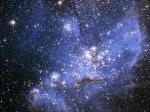 The nebula NGC 346 in the Toucan
The nebula NGC 346 in the Toucan
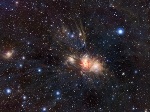 Nebula NGC 2170 seen by VISTA
Nebula NGC 2170 seen by VISTA
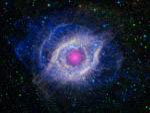 Helix Nebula, God's Eye
Helix Nebula, God's Eye
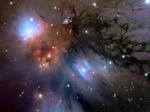 The most beautiful nebulae
The most beautiful nebulae
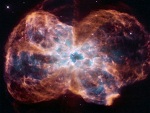 The death of stars seen by hubble
The death of stars seen by hubble
 Witch's Head Nebula
Witch's Head Nebula
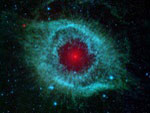 Type of nebulae, emission, reflection
Type of nebulae, emission, reflection
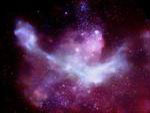 The X-rays emitted by the Carina
The X-rays emitted by the Carina
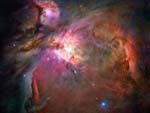 The famous Orion Nebula
The famous Orion Nebula
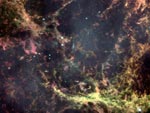 In the heart of the Crab
In the heart of the Crab
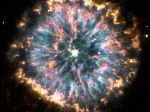 Planetary nebulae
Planetary nebulae
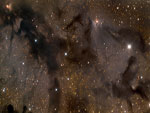 The light and dark of nebulae
The light and dark of nebulae